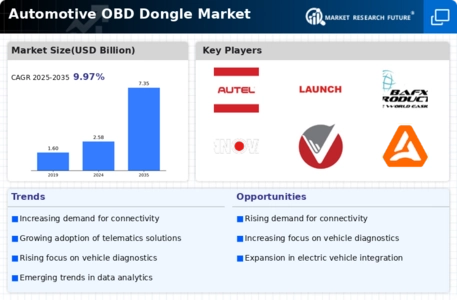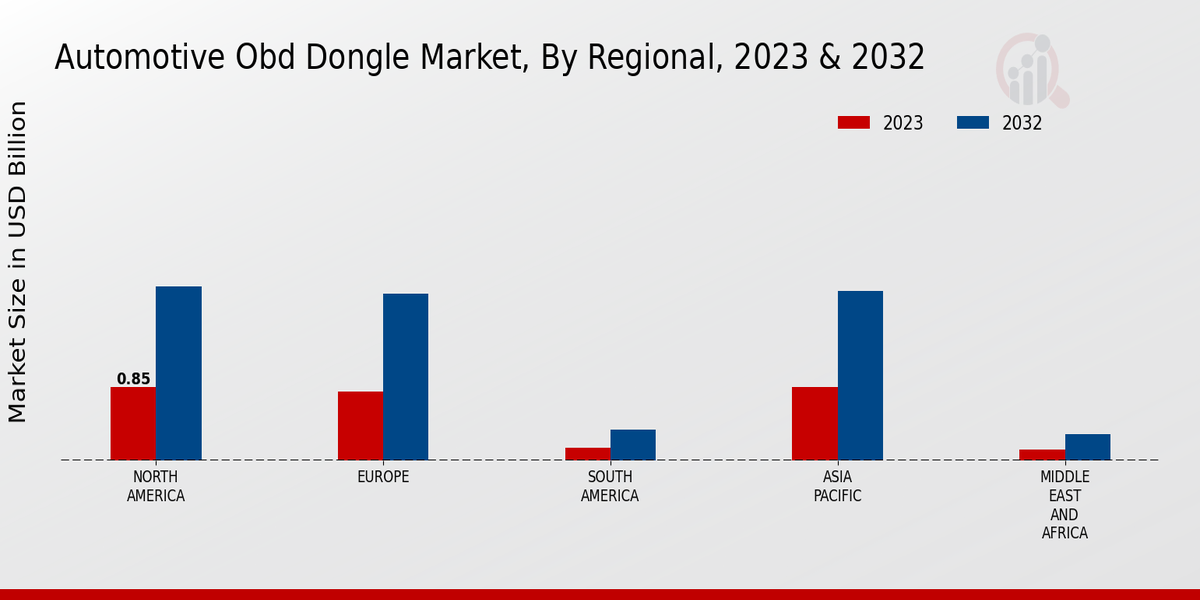Market Growth Projections
The Global Automotive OBD Dongle Market Industry is projected to experience substantial growth over the next decade. With an estimated market value of 2.58 USD Billion in 2024, the industry is expected to expand significantly, reaching 7.35 USD Billion by 2035. This growth trajectory indicates a compound annual growth rate of 9.98% from 2025 to 2035. The increasing integration of OBD technology in vehicles, coupled with rising consumer demand for diagnostics and connectivity, is likely to drive this expansion. The market's potential is underscored by the ongoing advancements in automotive technology and the growing emphasis on vehicle performance and safety.
Rising Adoption of Connected Vehicles
The surge in connected vehicle technology is significantly influencing the Global Automotive OBD Dongle Market Industry. As more vehicles become integrated with internet connectivity, the demand for OBD dongles that facilitate data exchange between vehicles and external devices is increasing. These dongles enable features such as remote diagnostics, software updates, and performance monitoring, enhancing the overall driving experience. The market is poised for substantial growth, with projections indicating a rise to 7.35 USD Billion by 2035. This shift towards connectivity not only improves vehicle functionality but also aligns with consumer preferences for smart technology.
Growing Demand for Vehicle Diagnostics
The increasing complexity of modern vehicles has led to a heightened demand for efficient vehicle diagnostics, driving the Global Automotive OBD Dongle Market Industry. As vehicles become equipped with advanced technologies, the need for real-time monitoring and troubleshooting becomes critical. OBD dongles provide users with the ability to access vehicle data, identify issues, and perform diagnostics conveniently. This trend is expected to contribute to the market's growth, with the industry projected to reach 2.58 USD Billion in 2024. The ability to enhance vehicle performance and safety through these devices is likely to attract both consumers and automotive professionals.
Technological Advancements in OBD Systems
Technological innovations in OBD systems are shaping the landscape of the Global Automotive OBD Dongle Market Industry. The development of advanced OBD protocols and the integration of artificial intelligence are enhancing the capabilities of OBD dongles. These advancements allow for more accurate diagnostics, predictive maintenance, and improved user interfaces. As technology continues to evolve, the market is likely to see increased adoption of sophisticated OBD dongles that offer enhanced functionalities. This trend aligns with the growing consumer expectation for high-tech solutions in vehicle management, further propelling market growth.
Increased Consumer Awareness and DIY Culture
The rise of consumer awareness regarding vehicle maintenance and the growing DIY culture are key factors influencing the Global Automotive OBD Dongle Market Industry. Consumers are increasingly seeking tools that empower them to monitor their vehicle's health and perform basic diagnostics independently. OBD dongles cater to this demand by providing accessible data and insights into vehicle performance. This trend is likely to enhance market growth, as more individuals recognize the benefits of utilizing these devices for proactive vehicle care. The shift towards self-sufficiency in vehicle maintenance is expected to drive sales and adoption of OBD dongles.
Regulatory Compliance and Emission Standards
Stringent regulatory frameworks regarding vehicle emissions and safety standards are propelling the Global Automotive OBD Dongle Market Industry. Governments worldwide are implementing regulations that require vehicles to be equipped with OBD systems to monitor emissions and ensure compliance. This regulatory push is driving manufacturers and consumers to adopt OBD dongles that facilitate compliance with these standards. As a result, the market is expected to experience a compound annual growth rate of 9.98% from 2025 to 2035. The integration of OBD technology into vehicles not only aids in regulatory adherence but also promotes environmental sustainability.












